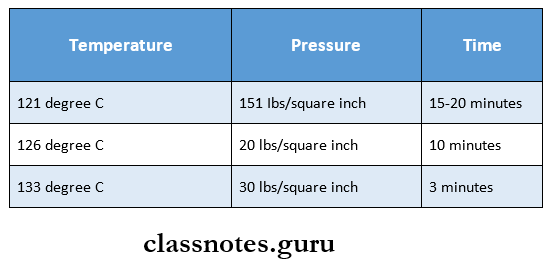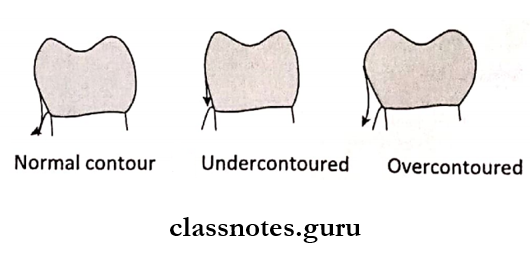Sterilisation And Infection Control Important Notes
1. Critical Items
- Includes instruments that contact tissues or penetrate tissues
- Usually, there are disposable or single-use items
- Example: scalpels, blades, endodontic files, syringes, etc
2. Semi-Critical Items
- Items that are handled by gloved hands coated with blood and saliva or that may touch mucosa
- These can be either disposable or they can be cleared, sterilized or disinfected
- Example: air water syringe tip, suction tips, prophy angle, handpiece
3. Noncritical Items
- These are environmental surfaces such as chairs, benches, floors, walls, and supporting equipment
- They are not ordinarily touched during treatment
- These surfaces can be cleaned, disinfected, and covered
Read And Learn More: Operative Dentistry Short And Long Essay Question And Answers
Sterilisation And Infection Control Long Essays
Question 1. Discuss various methods of sterilization.
Answer:
Various Methods Of Sterilization:
Sterilization:
Sterilization is defined as the process by which an article, surface, or medium is freed of all living organisms either in a vegetative/spore state. Its method is.

Sterilization Steps:
1. Presoaking:
- Prevent drying of blood, saliva, and debris
- Facilitate cleaning
2. Cleaning:
- Remove blood and saliva
Sterilization Types:
- Manual – Use of nylon brushes + detergents
- Ultrasonic – Provide fast and thorough cleaning
- Enzyme cleaning – Has specific catalytic behavior
3. Packaging:
- Protects instruments from contamination after sterilization and before use
Sterilization Materials:
- Self-sealing
- Paper plastic
- Peel pouches
- Sterilization
- Monitoring of sterilization
- Handling of processed instruments
Sterilization Of Different Instruments:

Question 2. Infection Control.
Answer:
Infection Control Methods:
Immunization: Vaccination recommended for Hepatitis B for all dental personnel
Personal Barrier
1 Handwashing:

2. Gloves:
- Protects against contamination
- Changed between patients and for the same patient if it is worn/torn
Infection Control Types:
- Surgical
- Latex
- Vinyl
- Double gloves for HBV and HIV [Hepatitis B Virus and Human Immunodeficiency Virus]
1. Face masks:
- Protects from inhalation of aerosols
- Prevents spatter from patient’s mouth
- Prevents splashes of contaminated solution
- Changed once per hour/between patients/whenever it becomes moist
2. Protective clothing:
- Reusable/disposable gowns with long sleeves, high neck, and long knee length
3. Eyewear:
- Prevention against Hepatitis B
- Prevent bacterial/viral contact
Infection Control Surgical Asepsis:
- Preparation of surgical site
- Draping the patient
- Isolation
Infection Control Surface Asepsis:
- Sterilization of instruments
- Use of disposable instruments
- Wrapping with aluminum foil or applying disinfectant to things that are often touched during treatment such as dental light, chair
Infection Control Disposable of waste:
- Methods:
- Incineration
- Burial in a landfill
- Discharge of liquid to a sewer
- Sterilization
Sterilization And Infection Control Short Essays
Question 1. Hot Air Oven.
Answer:
Hot Air Oven:
Component:
1. Chamber with double wall
- Inner-copper plate
- Outer – Asbestos
2. Adjustable holes – Monitor time and temperature
3. Thermostat – Regulate temperature
Hot Air Oven Time And Temperature:
- 160°C – 1 hour
- 180°C – Vz hour
Hot Air Oven Instruments That Can Be Sterilized:
- Glassware, forceps, scissors, scalpels, swabs
Hot Air Oven Precautions:
- Fitted for even distribution of air
- Not overloaded
- Arranged to allow free circulation
- Cooled for 2 hours before opening the door.
Question 2. Autoclave.
Answer:
Autoclave:
Principle:
- Water boils when its vapor pressure equals that of the surrounding atmosphere
- Steam is produced
- Autoclave condenses to water as it contacts the surface and transfers its latent heat to it.
Autoclave Time And Temperature:
- 121°C – 15 minutes at 15 lbs pressure
- 136°C – 3 minutes at 30 lbs pressure
Articles That Can Be Sterilized
- Culture media, saline, syringes, needles, dressings, gloves, aprons, gowns
Autoclave Advantages:
- Rapid
- Effective
- Good penetration
Question 3. Glass bead sterilization.
Answer:
Glass Bead sterilization:
- A rapid method of sterilization
- Salt used: 1% sodium silico-aluminate, sodium carbonate, or magnesium carbonate
- Salt is replaced by glass beads provided the beads are smaller than 1 mm in diameter as larger beads enable to transfer of heat to the endodontic instrument
- Time: 5-15 seconds, Temperature – 437 – 465°F
Glass Bead sterilization Disadvantage:
- The handle portion is not sterilized
Glass Bead sterilization Advantages:
- Economic
- Salt does not clog the root canal
Sterilisation And Infection Control Short Answers
Question 1. Autoclave
Answer:
Autoclave:
Autoclave is the process of sterilization by saturated steam under high pressure above 100 degrees C temperature
Autoclave Sterilization Conditions:

Autoclave Uses:
- Articles sterilised in autoclave are:
- Culture media
- Rubber articles like tubes, gloves, etc
- Syringes and surgical instruments
- OT gowns, dressing materials
- Endodontic instruments
- Hand instruments
Question 2. Contour.
Answer:
Contour:
- Buccal and lingual surfaces of teeth possess some degree of convexity
- Facilitate seepage of food
- Present over cervical third on facial surfaces of all the teeth, lingual surfaces of incisors, and canines.
- Middle third – On lingual surfaces of posteriors
Contour Significance:
1. Normal contour
- Shunt food toward the buccal vestibule
- Stimulate intervening tissues
2. Over contour
- Plaque accumulation
- Interferes with self-cleaning action
3. Under contour
- Opening of embrasure
- Affect the gingival

Question 3. Contacts.
Answer:
Contacts:
Contacts Significance:
- Broad Contact Faciolingually
- Prevents seepage of food
- Broad Contact Occlusogingivally
- Sticky food is held
- Irritates gingiva
- Contact Located Apically
- Packing of sticky food
- Impinges tissue
- Contact Located Initially
- Predisposes to proximal caries
- Prevents food being pushed into embrasures
- Contact located buccally
- Loose Contact
- Food lodgement
- Gingival problems
- Caries
Question 5. Embrasures.
Answer:
Embrasures:
- V-shaped spaces originating at the proximal contact area between adjacent teeth
- Types – Facial, lingual, incisal/occlusal and gingival
Embrasures Functions:
- Serve as spillways for the escape of food
- Prevents forcing the food into the contact area
Sterilisation And Infection Control Viva Voce
- Disinfectants containing 70-90% ethyl alcohol are considered the most effective disinfectants on cleaned surfaces
- Sterilants used for high-level disinfection of items for reuse are glutaraldehydes at 2-3 % concentrations
- Sterilization must be tested routinely
- Autoclave is done at 121°C temperature for 15 min at 15 lb pressure
- Chemiclave is done at 131°C for 30 min at 20 lb pres-sure
- Too little contour may result in trauma to the attachment apparatus
- Improper contact can result in food impaction between teeth
- When embrasures are decreased in size, additional stress is created on teeth
- Lingual embrasures are usually larger than facial embrasures
